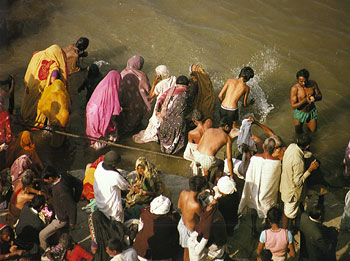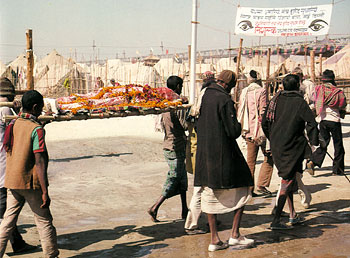






death at kumbha mela
In the thousands of tents erected on the festival grounds, pilgrims and holy men conversed on spiritual subject matters, previous Kumbha Melas, and upcoming events of the day. Sometimes discussion turned to reflecting on the good fortune of one who dies during the Kumbha Mela, as it is considered a blessing when a soul passes away from the world at such an auspicious time.
Early one morning while walking along the bank of the Ganges, we encountered a cremation. An elderly sage with white hair and beard, clad only in a loincloth, lay upon the funeral pyre, his hands poised peacefully at his side, his eyes turned toward the heavens. This saintly man had come to the Kumbha Mela like the millions of others seeking the ultimate benefit in life, and he had achieved it. A few of his disciples stood at a distance with tears in their eyes, looking on as the fire and smoke carried the soul of their guru away from this world. For them it was a time of both happiness and distress: happiness because their guru had attained liberation from the cycle of birth and death, and distress because of their feeling the pains of separation for one they loved dearly.
Death also claimed the lives of many pilgrims during the extreme cold wave that gripped the Kumbha Mela at its onset. At least one death occurred per night during the cold period, and there were also fatalities during the mass bathings. Despite the large crowds at the concentrated bathing areas, there were less fatal drownings at the 1989 Kumbha Mela than at any previously. Shallow water and competent lifeguards kept anyone from being swept away by the current, but four persons lost their lives when boats capsized at the boat dock or in midstream. These deaths were reported in the newspapers with remorse for the loss of life, yet the prevailing attitude was that one who dies at the Kumbha Mela is eternally blessed.





